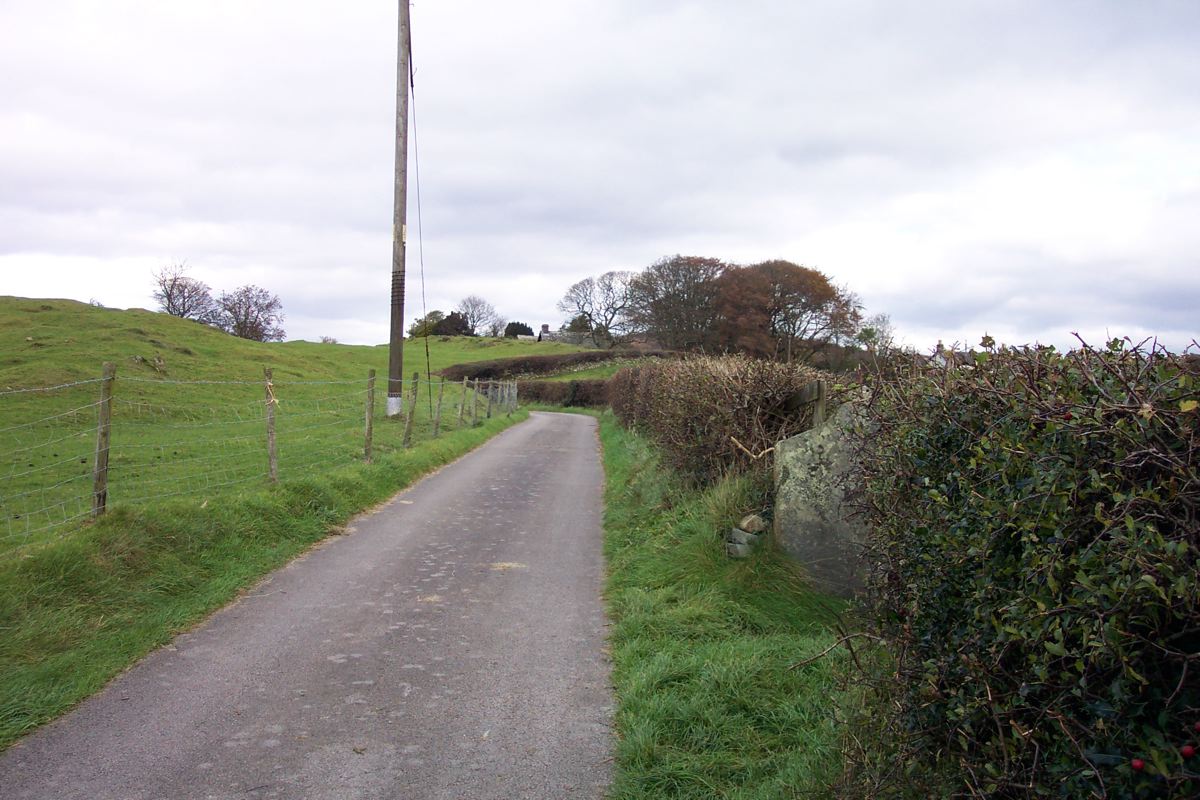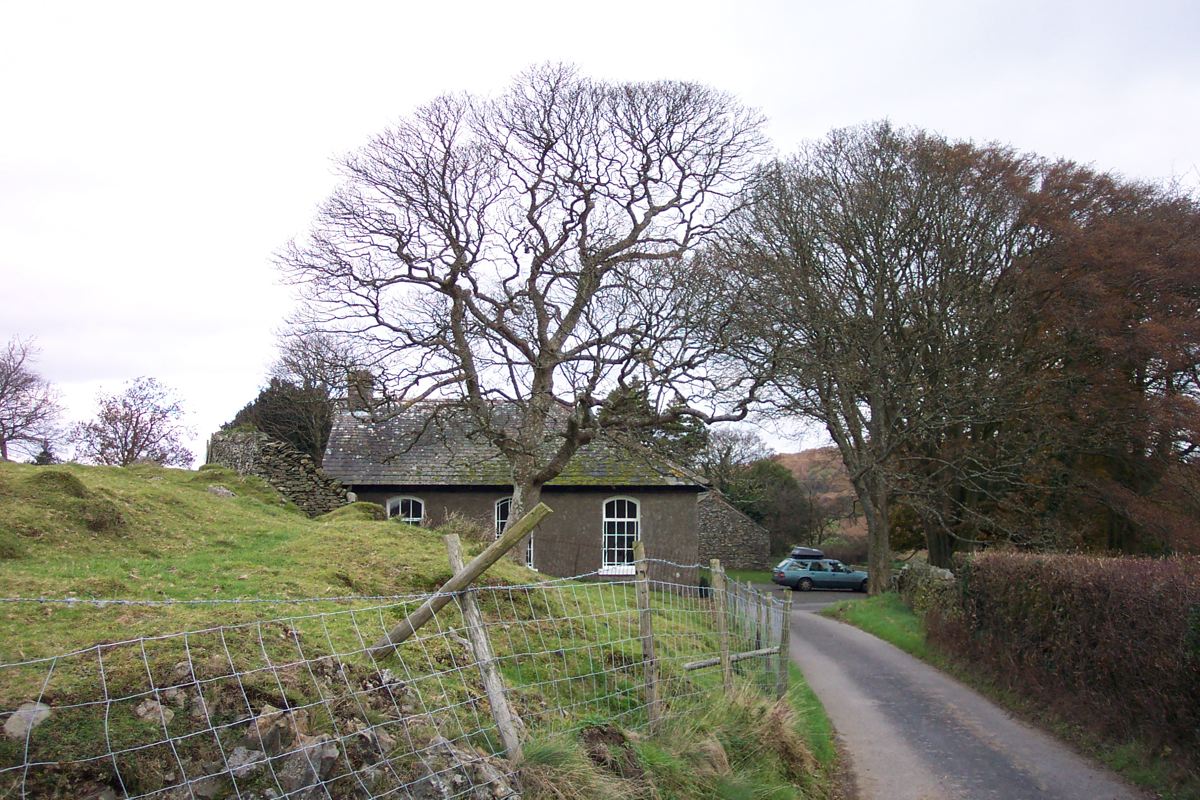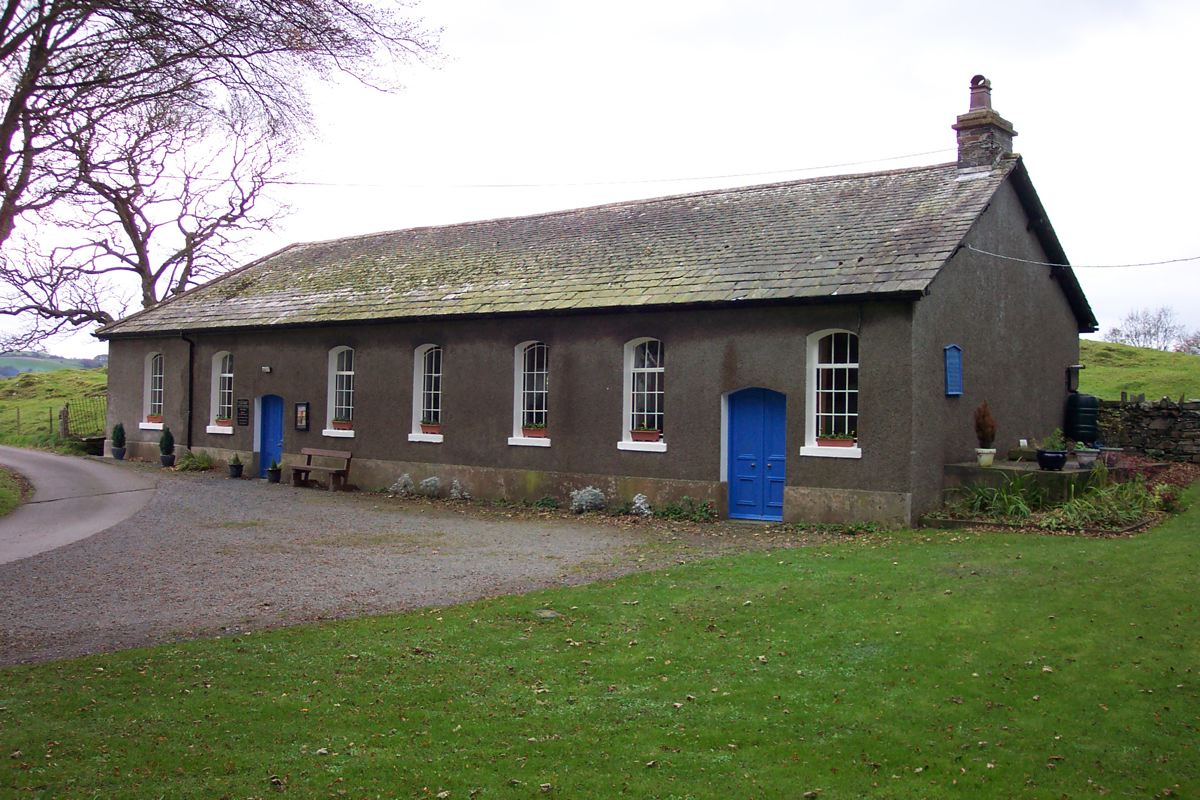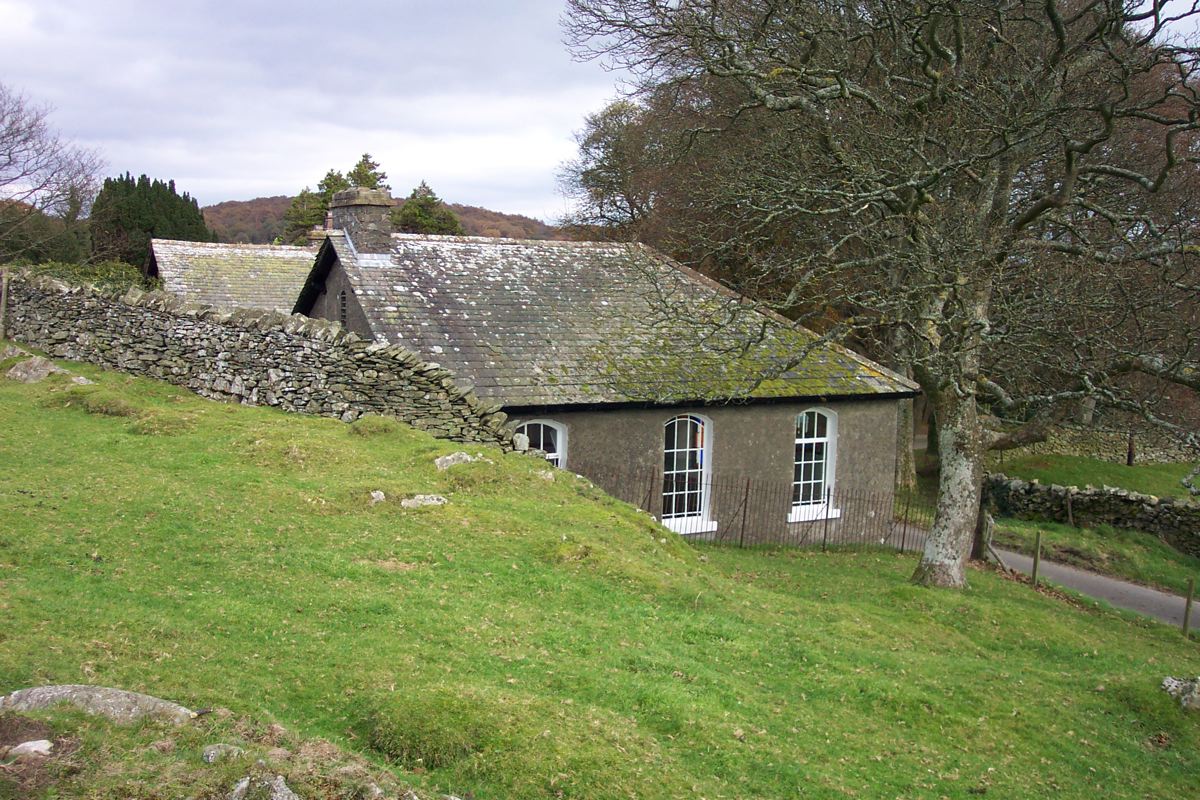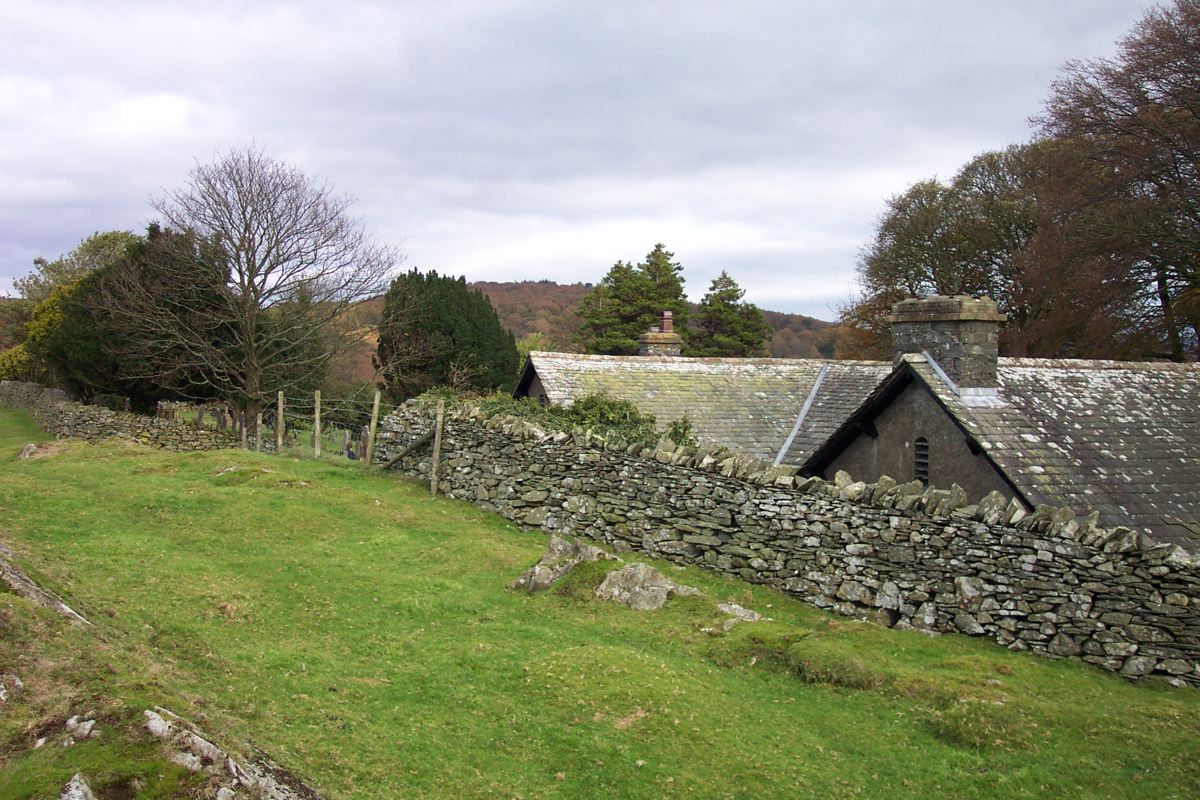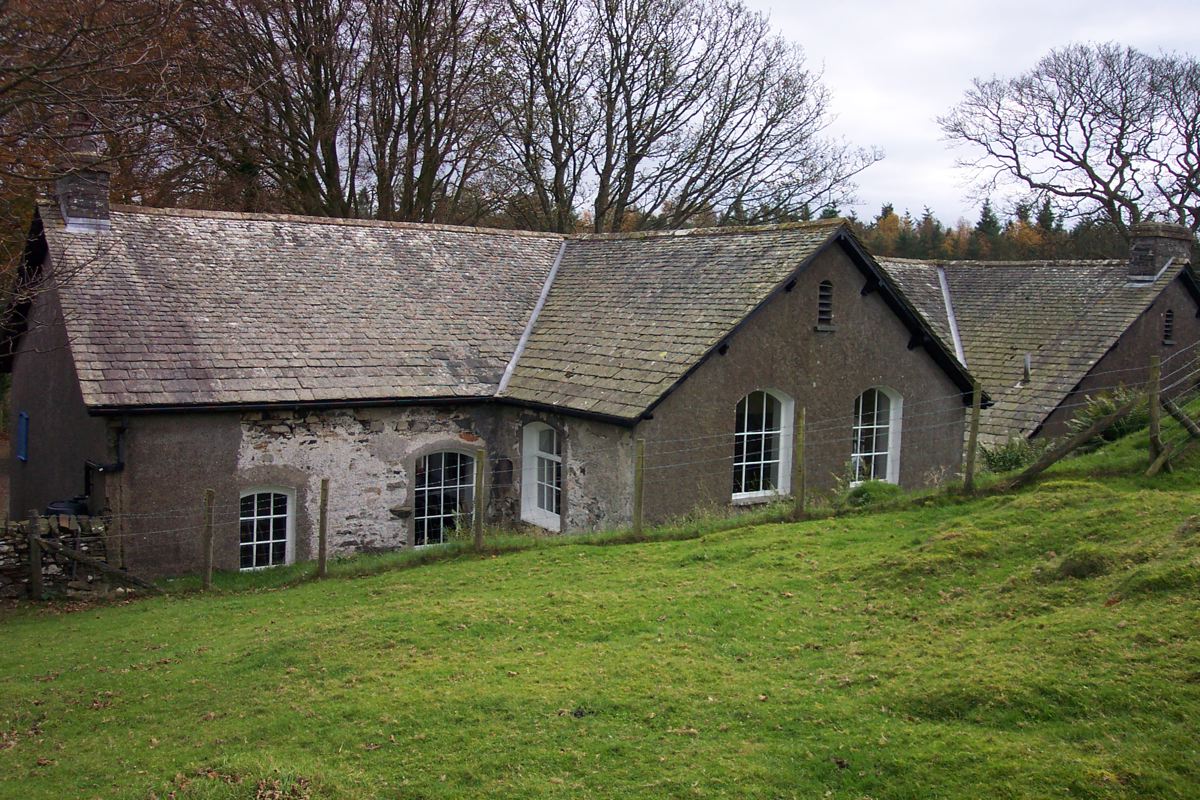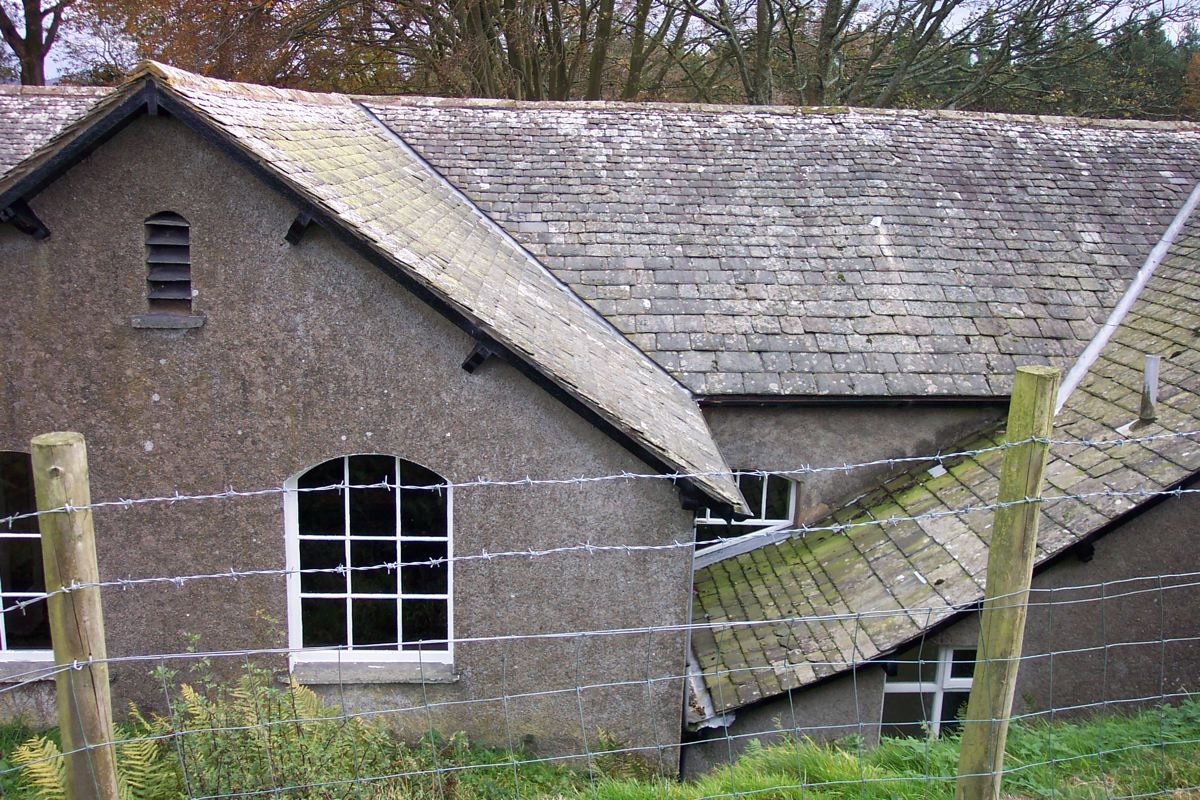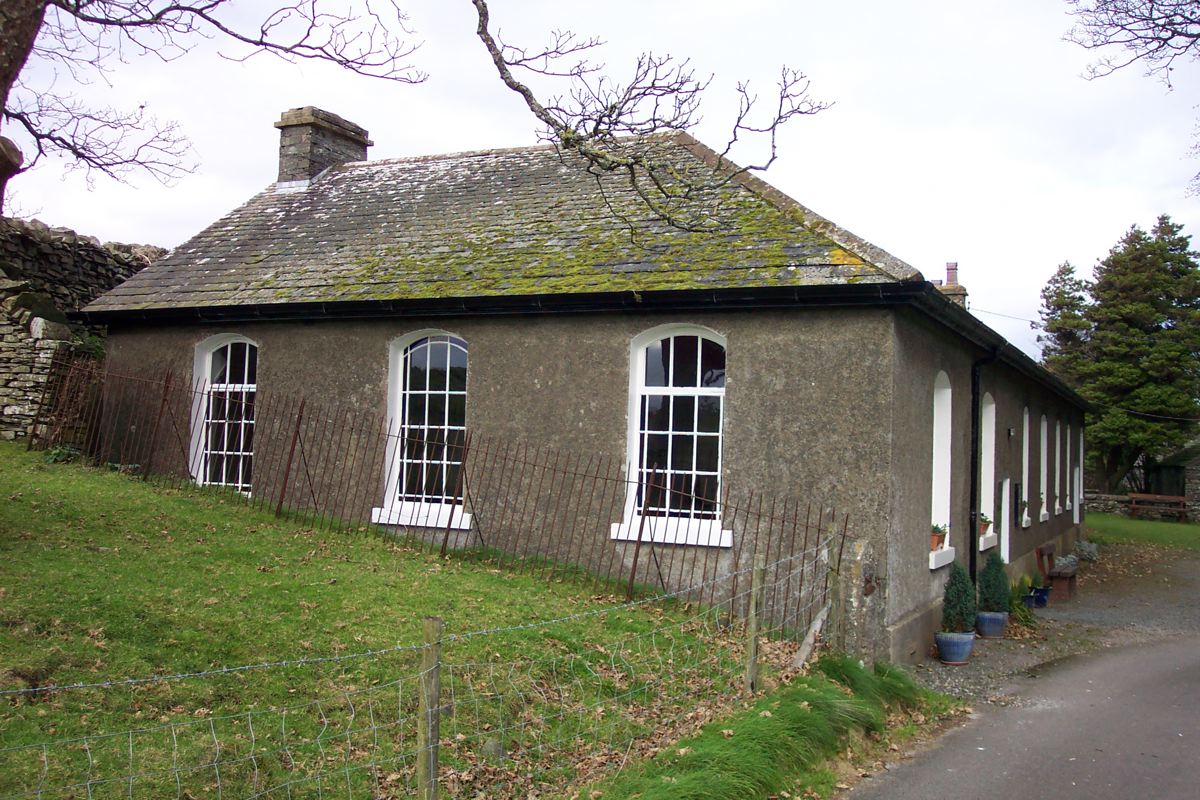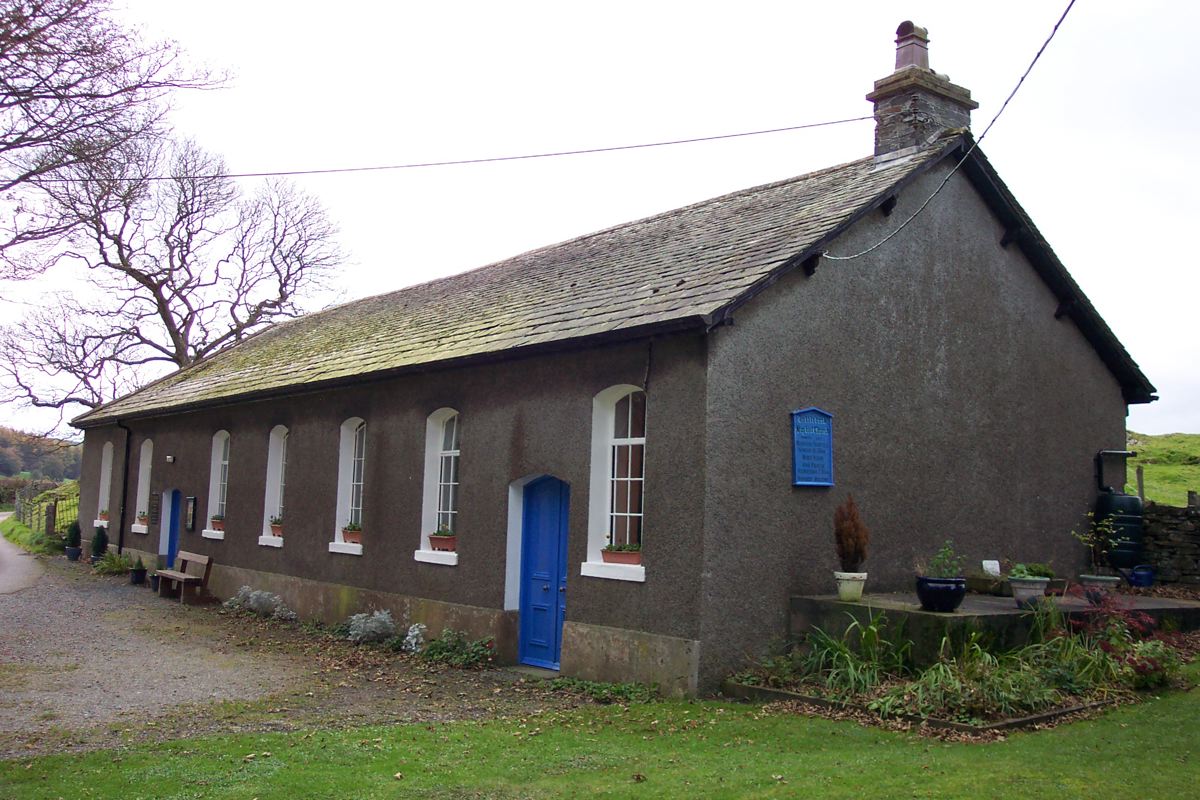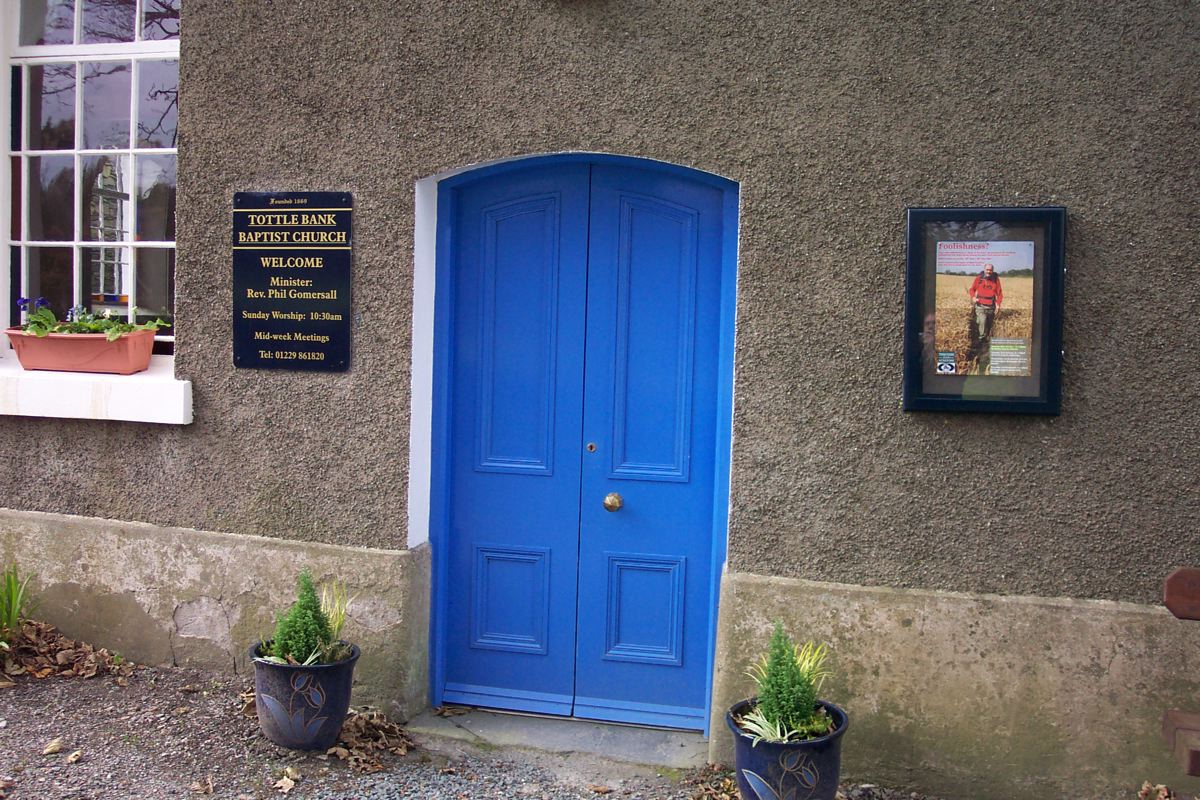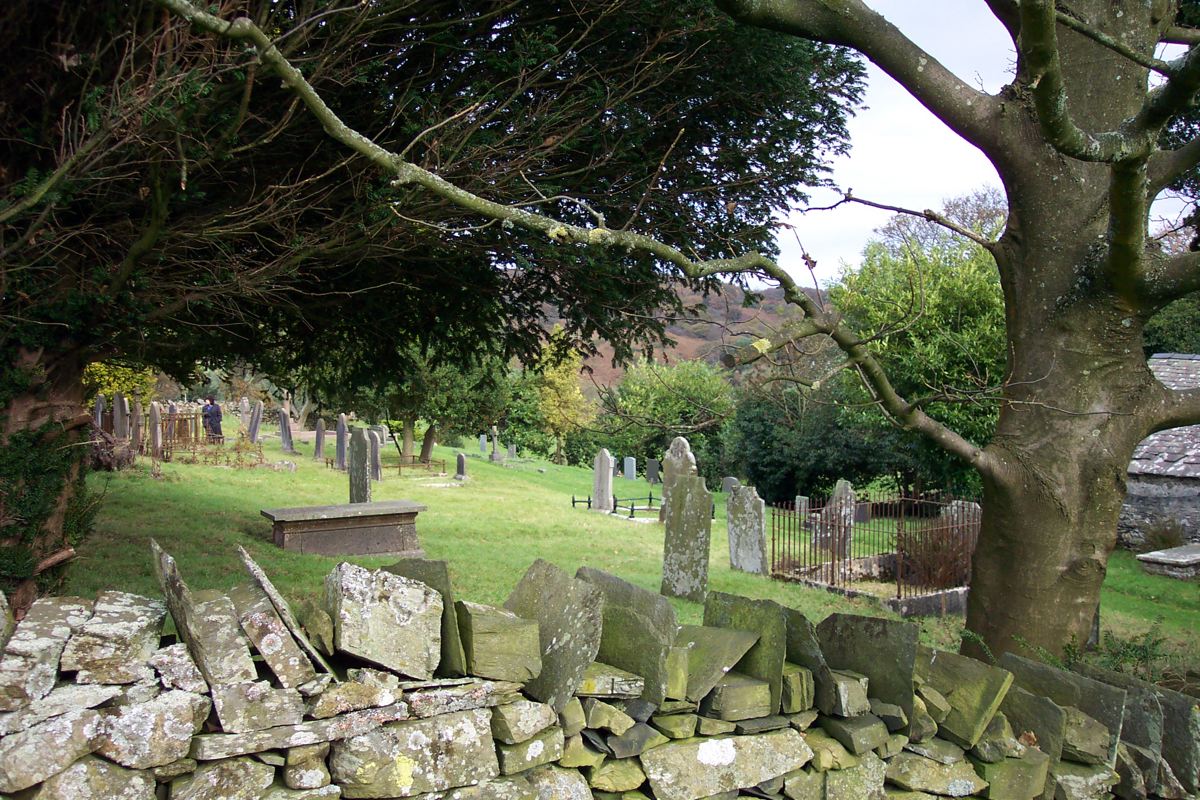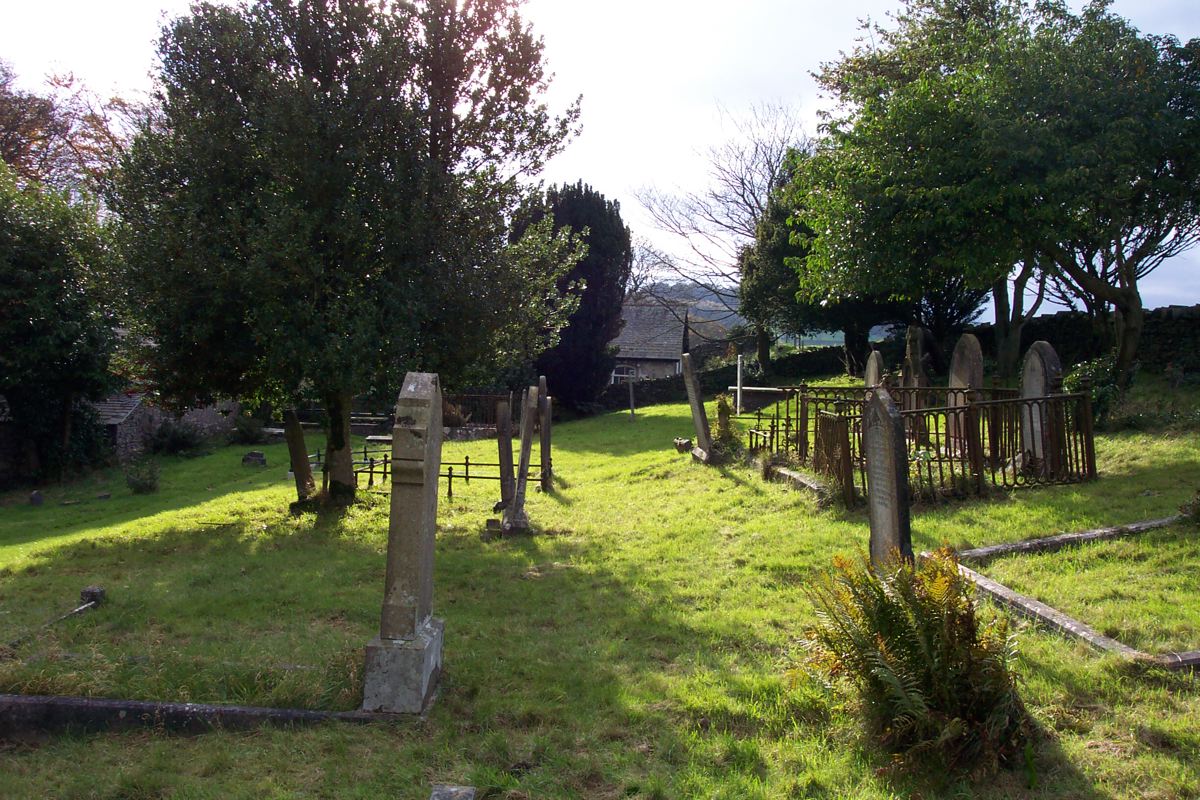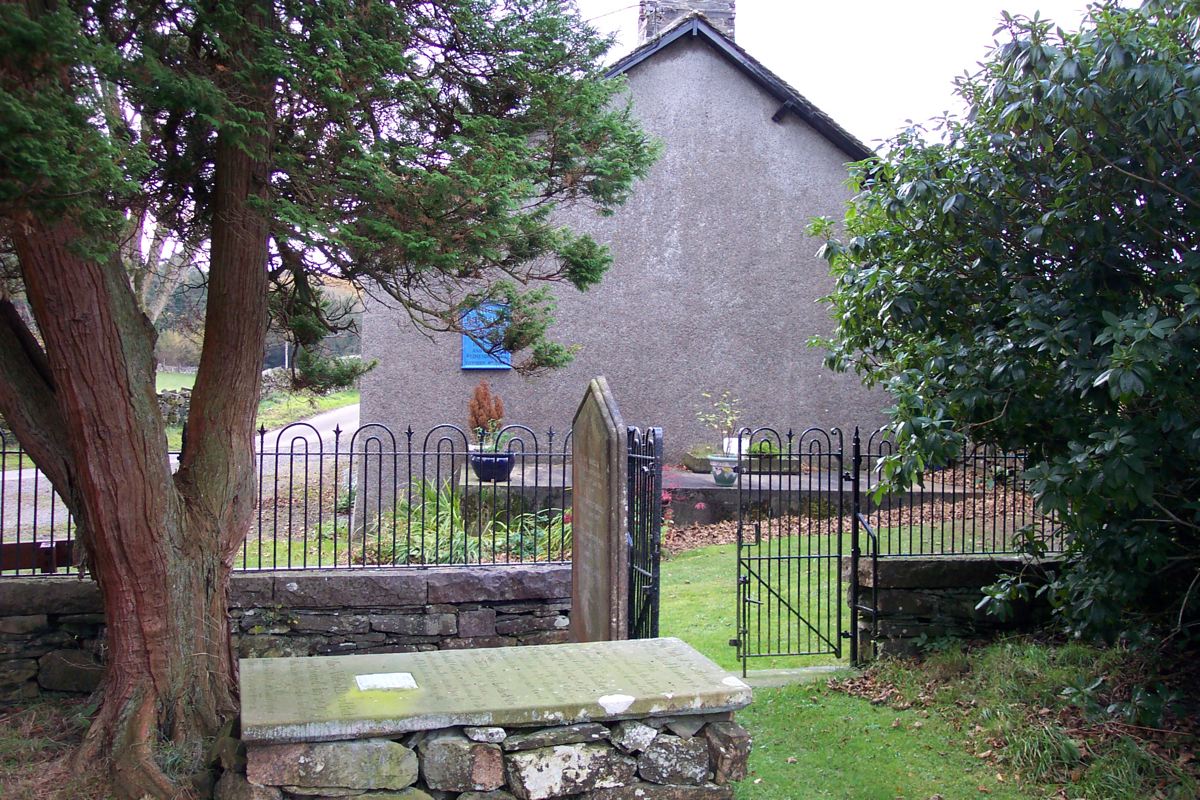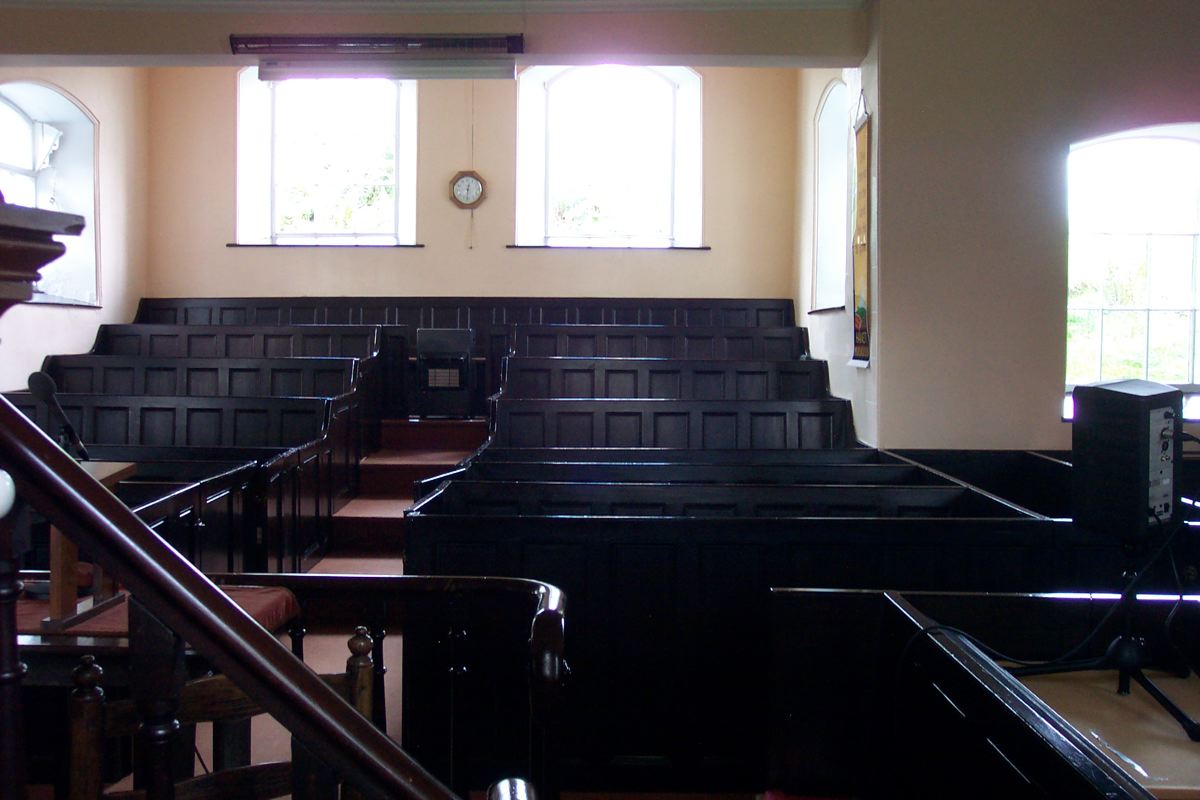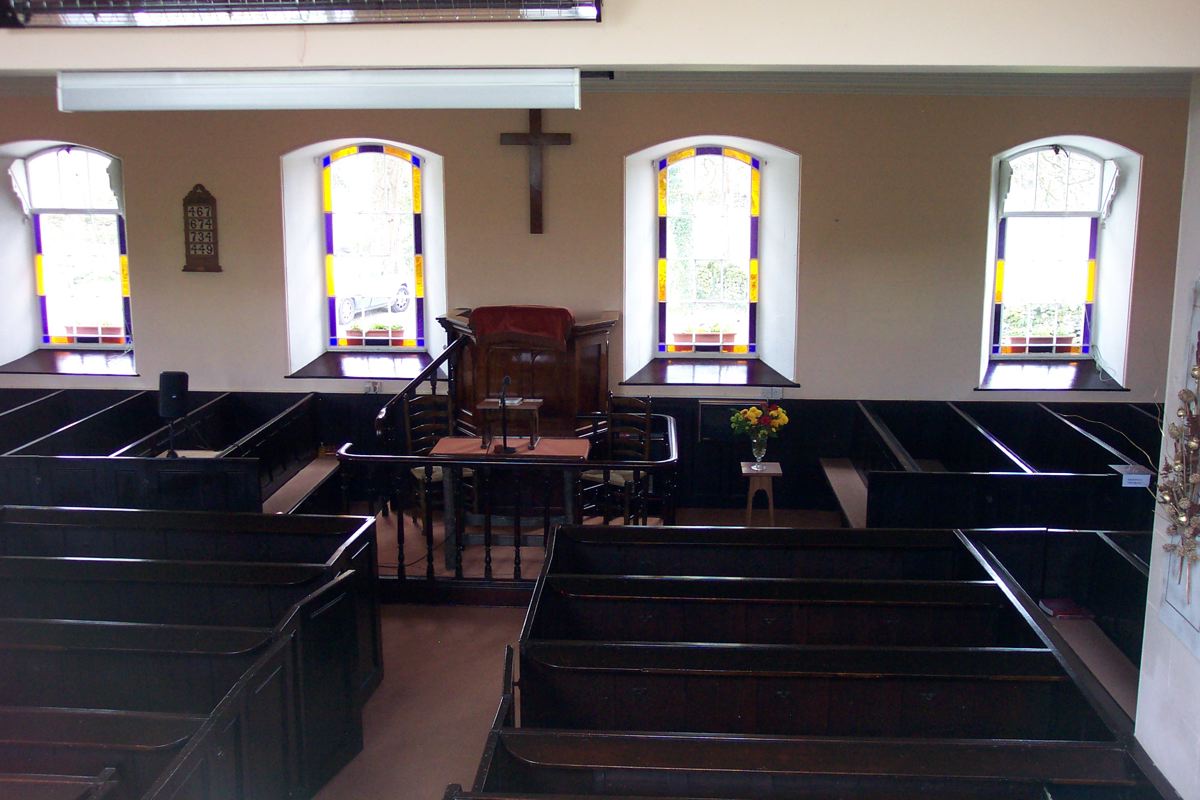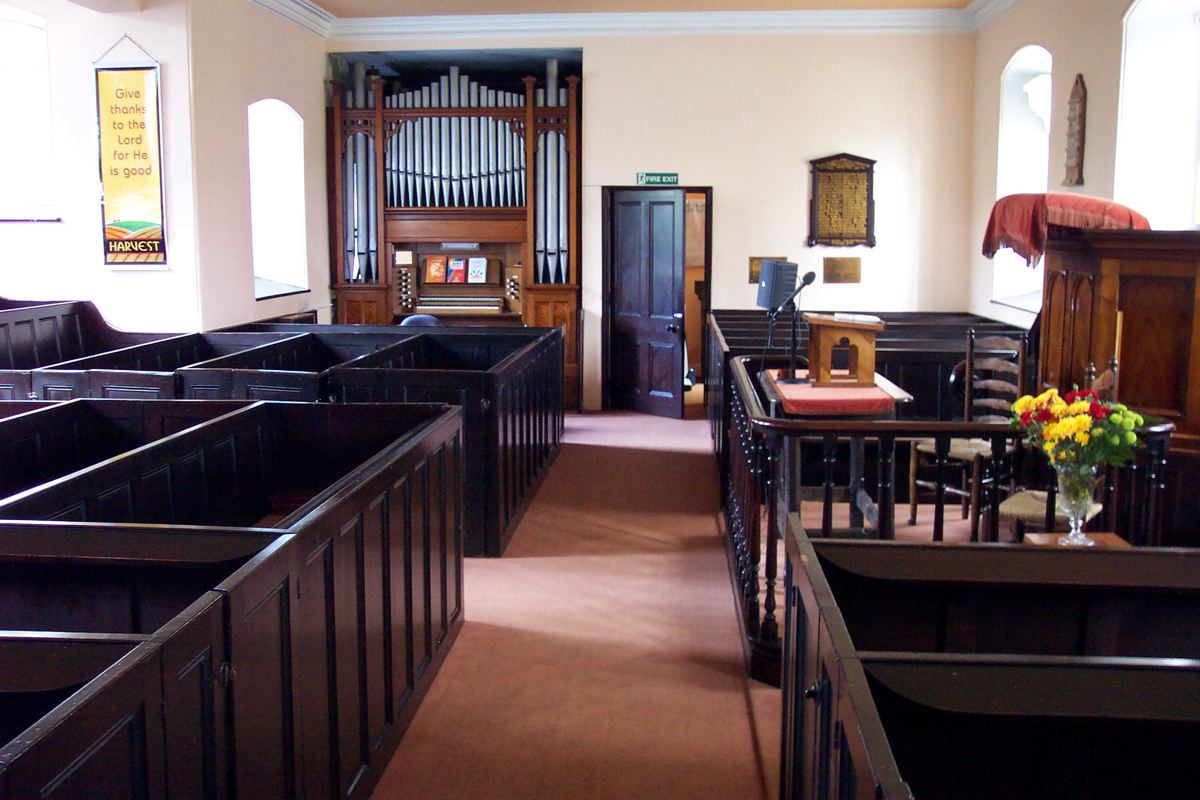A Church of Christ at Tottlebank In 1669
And Later, The Church of Christ At Kirkby
Tottlebank, Lake District, Northern England
![]()
Table Of Contents
Frontispiece To Church Book
A Little About Tottlebank & Kirkby
The Tottlebank-Kirkby Connection - Kilpatrick
Directions To Tottlebank
Photos Of Present Day Tottlebank
Directions To Kirkby - Wall End
Photos Of Wall End
William Robinson grave
What Churches of Christ Stand For - by W. Robinson
William McDougall grave
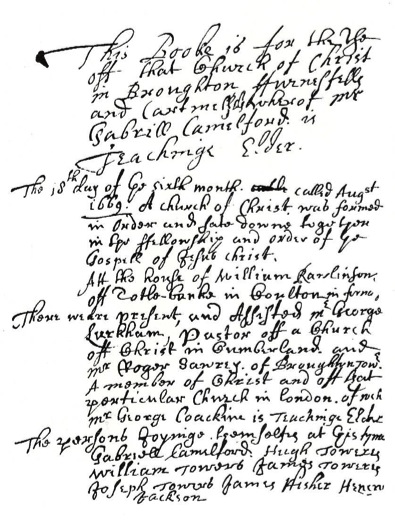
This booke is for the use of that Church of Christ in Broughton furnessfell and Cartmell whereof Mr. Gabrill Camelford is Teachinge Elder.
The 18th day of ye sixth month called August 1669 A church of Christ was formed in order and sate down together in the fellowship and order of ye Gospel of Jesus Christ. Att the house of William Rawlinson off Totle-banke in Coulton in furness.
There were present and assisted Mr Geroge Larkham Pasto off a Church off Christ in Cumberland and Mr Roger Sawrey of Broughton Tower a member of Christ and off that particular Church in London of wych Mr George Coackine is Teaching Elder
The persons joyning themselves at this time Gabriel Camelford, Hugh Towers, William Towers, James Towers, Joseph Towers, James Fisher, Henery Jackson.
A Little About Tottlebank & Kirkby
In 1669, Charles II had been on the English throne for nine years. Despite Charles’ inclination toward toleration, the early years of his reign were marked by a series of repressive measures, collectively known as the Clarendon Code.Under the Code grave disabilities were placed on those who sought to worship outside the boundaries placed on them by the English church. In particular the Conventicle Act banished any meetings of more than five people in addition to the household for worship other than in the prescribed form and location. Seven fled, two of whom had suffered severe penalties for violation, sought seclusion and solitude from London’s watchful eye! They settled in England’s Northern Lake District, 200 miles to the NW of London. In 1669 the Convenicle Act ran out, and during the brief period before it was reinacted, The group drew up articles of organization as noted on the copy above.
Then, On 9th of November, 1669, articles of faith were drawn up. It began, “The Confession off ffaith held forth by the Church off Christ . . .” Some things the lengthy document claimed: "The way of separation from the world is the way off God . . .with us is a door wide enough to entertaine every Sonn of ye lord of glory, we dare not barr the dore against any honest soule …desieringe much that we may all be helpful to each other…our table is large enough and provision suited for children, younge men and ffathers amonge the flock of Christ that shall consent with us and desier to sit down with us or amongst us.”
Seven basic principles of faith were listed according to Tottlebank Historian Foster Sutherland, 1969:
–Repentance, Faith, Baptism of water and the spirit, laying on of hands, resurrection of the dead and eternal judgement.
–Thankfulness to God and willingness to be the praise of His grace.
–Dear love and affection to all saints.
–The chiefest tie and bond is the bond of love, Christian, heavenly and unfeigned love.
–The word of Christ is the utmost boundary of liberty.
–“We desire and expect to receive help in our weakness and from another by the watchful aid of one another and the faithful reprehension and admonition one of another.”
–Everything is to be referred to God and Christ, and when all is done they are to say, “Not unto us but unto Thy name be praise.”
Infant baptism vs. adult baptism is not discussed in the book of faith. They claimed church autonomy, having rights to its own affairs, claiming freedom to choose its own officers, to examine disagreements or “matters of scandall any way arrising amonge themselfes,”and to discipline if necessary by suspension, “on occation of obstinace and wilfull persistinge in any ennormous sinn,” with exclusion as the final resort.
In 1695, London Minister, David Crossley introduced Baptist Theology, and the church became identified as a Baptist church, and is so to the present.
The Tottlebank church planted a church near the west coast that for years remained in fellowship with them. By 1824, a church after the ancient order was serving the Lord at Kirkby. It was 30 years before any hear of Barton W. Stone or Alexander Campbell. When the battle over the instrument raged, the Kirkby church added the instrument to its services. Today Kirkby church is known as Wall End Christian Church. It is the oldest continuous restoration related church in Great Britain.
The Tottlebank church has long been sighted as an example of how people, seeking religious freedom, simply strove to go to the Scriptures for their authority in all religious matters. It is debated as to whether they gave up denominational ties, but the effort is worthy of remembrance.
THE TOTTLEBANK-KIRKBY CONNECTION AND THE RESTORATION MOVEMENT
A Historical Sketch
to be used in
Class Presentation
Complimentary to
RESTORATION MOVEMENT A
HIST 312
by
Wayne Kilpatrick
December 1977
![]()
TABLE OF CONTENTS FOR THIS RESEARCH PAPER
Introduction
Tottlebank
Kirkby
A Second Glance
Bibliography
When one thinks about the British Restoration Movement, he naturally thinks back to the summer of 1833 in London when "a young man of fair complexion, medium height, and of a sprightly appearance"("General Evangelist Committee Report," The Christian Advocate 5 (August 1883):359.) entered an unpretentious looking building used as a chapel for a Scotch Baptist Church. This young man, Peyton C. Wyeth, an American artist (a friend of Alexander Campbell), had been studying in Paris. Here he met William Jones, one of the elders, in the little chapel. Wyeth and Jones talked about the American "reformation" and Jones learned of Alexander Campbell. From this meeting correspondence ensued between Campbell and Jones. Jones printed Campbell's views for about sixteen months in his paper, The British Millennial Harbinger and Voluntary Advocate. Campbell's teachings thus were introduced to the British public. Jones wrote reflecting his surprise of hearing Campbell's name mentioned by Wyeth: "I requested to be favored with some of the names of leading persons, particularly such as elders of churches, and was not a little surprised to hear the first name mentioned was that of Alexander Campbell, the antagonist of Robert Owen, Esq., whose public disputation on the evidences of Christianity, reprinted in the World-newspaper a few years ago, I read, at the time, with peculiar interest, without the slightest suspicion that his views of divine truth and gospel-worship were so congenial with my own." (William Jones, "Epistolary Correspondence Between Christian Churches in America and Europe," The British Millennial Harbinger and Voluntary Advocate 1 (March, 1835):16.) From this relationship of correspondence between Campbell and Jones, most people think of the British Restoration Movement as beginning. This just isn't the case.
Our British brethren wrote: "But it would be a mistake to suppose that there were no germs of reformation in the United Kingdom before Mr. Jones began publication of his Millennial Harbinger; for a careful glance through our early magazines, reveals the fact that several churches, in various places, arose about the same time, and previous to obtaining any knowledge of Mr. Campbell and his work. These, for the most part, unknown to each other, but were teaching and upholding the same things. In the north were Auchtermuchty and Grangemouth; in the south, Bristol and probably London; between these distant points were found churches in Coxlane, Wrexham, and Shrewsbury; also, one in Dungannon, Ireland."("General Evangelist Committee's Report," p. 360.) Lancelot Oliver tells of "Rose Street, Kirkcaldy--which began as far back as 1798."(Lancelot Oliver, New Testament Christianity (Birmingham, England: Publishing Committee of Churches of Christ, 1911):206.) These churches stood isolated for years, but "steadfast in the Apostles' doctrine, the fellowship, the prayers, the teaching, and breaking of bread on every first day of the week."("General Evangelist Committee's Report," p. 361.) Each, in turn, were equally surprised and pleased to find it was not alone in pleading for a restoration of the ancient order. How these churches came to exist may be accounted for by the fact that during the greater part of the eighteenth, and early part of the nineteenth century, God's Word had been moving the minds of such men as John Glas, Robert Sandeman, the Haldanes, Archibald McLean, and others, to please for a restoration of the pure Gospel. There were, however, some movements whose beginnings started in the middle part of the seventeenth century. It is the purpose of this paper to discuss one such movement and its contribution to the British Restoration Movement.
Lying between Cumberland and Westmoreland, and entirely separated from most of Lancashire by an arm of the sea and swampy salt marshes filled with quicksand, lies the mountainous promontory of Furness. Here was situated among the Furness Fells, Tottlebank, which has been called "the first Christian Church in England."
Robert Halley wrote concerning Tottlebank:
It has been disputed where was formed the first Congregational Church in England. Islington, Yarmouth, Southwark, Dukinfield have claimed the honour. Among the fells of Furness was founded the first Christian Church in England. By Christian I mean here not Congregational, not Presbyterian, not Episcopal, not Baptists, but simple Christian in its unrestricted sense--Christian not sectarian, Catholic not denominational, a church of people acknowledge as Christians and nothing else. A poor ejected minister from over the sands had the wisdom and grace to form such a church, and the poor mountaineers of his neighborhood had the piety firmly to adhere to it and long to sustain it.(Robert Halley, Lancashire: Its Puritanism and Nonconformity (Manchester, England: Tubbs and Brook Pub., 1869):208.)
Who was this poor ejected minister, and how did Tottlebank Church arise?
Archbishop Laud had dealt severely with the Puritans in the reign of Charles I, but under the Commonwealth the attempt to make all people think alike in religion had been abandoned. Cromwell's concern that the church should have a godly and competent ministry had led to a religious settlement, which was thought to be the most tolerant ever in England at that time.
Before Charles II came back to England and took the throne, he promised religious tolerance in the Declaration of Breda. But when enthroned, the Anglicans forced through Parliament, the successive acts known as the Clarendon Code. Persecution of nonconformist followed. In 1662 the Act of Uniformity was passed and it required all ministers in the Church of England to declare that they wholly accepted the Book of Common Prayer. Many earnest Puritans, who had entered the ministry, could not conscientiously make such a declaration. On St. Bartholomew's Day, August 24, 1662, nearly two thousand ministers were ejected from their livings.
One of the ejected ministers was Gabriel Camelford, Vicar of Staveley, in Cartmel, a village near the foot of Lake Windermere, in Lancashire. "Although ejected, he would not be silenced, as he felt a woe upon him if he preached not the gospel. Beloved, not only in his own chapelry, but through all the lake country, he resolved to live and die preaching wherever he could find hearers, by the side of the lakes or in the shelter of glens."(Robert Halley, Lancashire, p. 208.) One of the men he met was a Cromwellian soldier, Roger Sawrey, of Broughton Tower. "Sawrey was an earnest Puritan who had earned the title of 'Praying Sawrey.'"(Foster Sunderland, Tottlebank Baptist Church (Liverpool: Unity Press, 1969):5.) Sawrey had aided many Puritans in his district. At Broughton Tower he sheltered many dissenting ministers. He sheltered men like Camelford and in 1664 was forced to abstain from all church services of the Anglican Church. In 1669 Sawrey and Camelford gave lead in promoting the establishment of the church at Tottlebank.
The old original minute book of Tottlebank Church is still preserved and bears the inscription, "This booke is for the use of that Church of Christ in Broughton, Furnessfells and Cartmell whereof Mr. Gabriel Camelford is Teaching Elder."(Church Book at Tottlebank Church (August, 1969).)
The first entry reads:
The 18th day of ye sixth month, called August 1669. A Church of Christ was formed in order and sate down together in the fellowship and order of ye Gospel of Jesus Christ. Att the house of William Rawlinson off Tottlebank, in Coulton in furness. There weare present and Assisted Mr. George Larkham, Pastor off a Church off Christ in Cumberland, and Mr. Roger Sawrey of Broughton tower. A member of Christ and of that particular Church in London of wch Mr. George Coackine is teaching Elder. The persons Joyninge themselves at this time, Gabriel Camelford, Hugh Towers, William Towers, James Tower, Joseph Towers, James Fisher, Henery Jackson."(Church Book at Tottlebank Church (August, 1969).)
Soon after its formation, the members met to agree upon a confession of their faith. It is entered in full in the minute book and takes fifteen pages. Sunderland(Foster Sunderland served as minister to Tottlebank Baptist Church from 1947 to 1949.) sums the confession up by stating its seven basic principles:
1. The six principles listed in Heb. 6: Repentance, faith, baptism of water and of the spirit, laying on of the hands, resurrection of the dead, eternal judgement.
2. Thankfulness to God and willingness to be the praise of His grace.
3. Dear love and affection to all saints.
4. The chiefest tie and bond is the bond of love, Christian, heavenly and unfeigned love.
5. The word of Christ is the utmost boundary of liberty.
6. "We desire and expect to receive help in our weakness one from another by the watchful aid of one another and the faithful reprehension and admonition one of another."
7. Everything is to be referred to God and Christ, and when all is done they are to say "Not unto us but unto Thy name be the praise."(Foster Sunderland, Tottlebank Baptist Church, p. 7.)
Sunderland was looking at the confession of faith through the eyes of a Baptist minister, and set down the above principles as such. William Robinson, who was a Disciple, sets down the basic principles of the confession of faith as follows:
1. The Church practiced only Baptism of Adults by Immersion.
2. The "Breaking of Bread" comprised the chief feature of the worship on each Lord's Day, and was limited to the baptized.
3. The government was congregational, and there was liberty in ministry. Elders and Deacons were appointed, and one Elder served as Teaching Elder, and was supported by the Church.(William Robinson, "A Short History of the Churches of Christ in the Furness District," The Christian Monthly 1 (January, 1920):3)
Sunderland's account is more in harmony with the Church Book than is Robinson's account. Firstly, Robinson said that "The Church practiced only Baptism of Adults by Immersion."(Ibid.) This is in error. The "six principles of Hebrews 6"(Church Book at Tottlebank Church (November, 1669).) does include baptism, but nothing was said about immersion in the confession. Furthermore, the first time baptism by immersion is mentioned in the Church Book at Tottlebank was "June 5th, 1725."(Ibid.) From this one can see that Robinson concluded the wrong thing concerning immersion from the confession of faith.
Secondly, Robinson stated that the breaking of bread "was limited to the baptized."(Wm. Robinson, "A Short History of the Churches of Christ in the Furness district," p. 3.) This is directly opposite of what is recorded in the confession of faith. The confession states:
With us is a door wide enough to entertain every form of the Lord of Glory. We dare not bar the door against any honest soul--our table is large enough and provision suited for children, young men and fathers among the flock of Christ that shall consent with us and desire to sit down with us or among us.(Church Book at Tottlebank Church (November, 1669).)
This doesn't sound as if the communion was limited to immersed believers only. Tottlebank was founded on the idea of religious tolerance--baptism or no baptism.
Robinson's wrong conclusions relating to the confession of faith have been incorporated into A. C. Watters History of British Churches of Christ.(A. C. Watters, History of British Churches of Christ, (Indianapolis: School of Religion, 1948):17.) It is possible that Watters never knew of the error in Robinson's deduction. Other writers have fallen into the same trap as did Watters. Many quotations of various forms from Robinson's article have circulated around the world, causing many to believe that Tottlebank was a true, or near New Testament church. Many churches of the seventeenth century had similar marks as those of the Lord's church, but what is weightier is the numerous doctrines and confessions of faith which differ with those of the New Testament church. Two of Robinson's points of similarity are wrong, so that only one is left with which to compare Tottlebank to the New Testament church. Tottlebank, after coming into the Baptist Union, did change its practices of worship which more closely resembled those of the Restoration Movement, but never can it be truthfully said that it was a true church of Christ.
Even though Tottlebank was not a true New Testament church, it did contribute to the restoration of the church. Some members of Tottlebank, who were living in nearby Kirkby, left Tottlebank "to worship the Lord more in accordance with New Testament teaching."(William F. G. Leake, "Kirkby Furness," The Christian Advocate 5 (January, 1883):44.)
Just what "to worship the Lord more in accordance with New Testament teaching" meant is debatable. Robinson recorded that a war over open and closed communion was fought in England amongst all churches which practiced immersion. Some of these churches began taking the "Lord's Supper" once a month also. Some churches kept closed communion and the taking of the Lord's Supper every Lord's Day. Robinson stated concerning Kirkby: "Among this latter group the Church at St. Mary's Well, Kirkby, is to be numbered."(William Robinson, "A Short History of the Churches of Christ in the Furness District," p. 4.) From his statement it sounds as if the Kirkby members left over open communion and the failure to partake the Lord's Supper every Sunday.
A. C. Watters, who relied upon Robinson for his sources, makes the following statement: "The church at Kirkby separated from the group (the Tottlebank Church) when the latter adopted Open Communion."(A. C. Watters, History of British Church of Christ, p. 18.)
Foster Sunderland writes: "differences arose between the Kirkby members and the Church (Tottlebank) about the observance of weekly communion and a paid ministry. At Kirkby the members were meeting every Sunday morning to break bread."(Foster Sunderland, Tottlebank Baptist Church, p. 17.)
Tottlebank requested that they either come back to worship each Sunday at Tottlebank or to hand in their intention to withdraw. It is recorded in the Church Book in 1824 that eight members were excluded from membership at Tottlebank,having embraced erroneous religious views absented themselves from our fellowship, and formed themselves into a separate body for the administration of the ordinances agreeably with their present notions.(Church Book (September 1824).)
From these four sources we can see that Robinson and Sunderland, who both read the church minutes, and Watters, who relied upon Robinson's research, all differ from each other slightly. The problem could have arisen from what is meant, in the church minutes, by "ordinances."(Ibid.) It seems that Sunderland and Robinson supplied their own meaning to the word, thus accounting for their different reasons for the breaking away of Kirkby from Tottlebank.
Another point of discussion is over the date of establishment of the Kirkby Church of Christ. Robinson writes:
It is not clear when this separation took place from the Church at Tottlebank. An undated, unsigned document in my possession says that it was a few years after 1826; but another account puts it as late as 1839.(Wm. Robinson, "A Short History of the Churches of Christ," p. 4.)
Watters wrote that, "In the remote peninsula of Furness there was a church at Kirkby, meeting in a chapel which was probably built in 1826, and the church must have been in existence for at least some years before that."(A. C. Watters, History of British Churches of Christ, p. 17.)
At the General Meeting held in Manchester on August 1, 1855, it was reported that the church was "formed in 1843."("Report of the General Meeting," British Millennial Harbinger 8 (Sept. 1855):453.) Wm. F. G. Leake stated, in an obituary notice in January 1883,
On Tuesday, 28th November, we followed to the grave the remains of our dear brother, John Johnstone, the oldest member in the Faith at Kirkby. He was amongst those who left the Baptist at Tottlebank many years ago, to worship the Lord more in accordance with New Testament Teaching.(Wm. F. G. Leake, "Kirkby, Furness," p. 44.)
The "many years ago" would be more in harmony with the 1820 decade supported by the unsigned, undated, document in Robinson's possession. Also the deduction made by Watters, concerning the disciples having been there some years before the building of the chapel in 1826, is a valid one. The 1820 decade fits the "many years ago" more so than the 1839 or 1843 date either. The following entry into the Tottlebank Church Book made in 1824, and reads as follows: "The members at Kirkby having embraced erroneous religious views absented themselves from our fellowship, and formed themselves into a separate body. . . ."(Church Book (September, 1824).) This clearly states that the Kirkby members had formed "a separate body," a separate church.
To further stress the significance of Leake's phrase "many years ago" the following comparisons are made:
1. The article by Leake was written in 1883.
2. Church Book gives date of separation 1824.
3. Watters' date is before 1826.
4. One statement given to Robinson was 1839.
5. Date in the General Meeting report was 1843.
Note:
1883-1839 = 44 yrs.
1883-1843 = 40 yrs.
1883-1824 = 59 yrs.
Conclusion: The 1824 date seems to be the most probably date of establishment for the Kirkby congregation.
Kirkby remained practically isolated from the time of its separation from the Baptist Union at Tottlebank until it was discovered by an evangelist of the cooperation churches of Christ in 1854. The chief figure of this time was George Barr, who came from Scotland. "He seems to have been a man mighty in the Scriptures, and a real patriarch of the flock."(Wm. Robinson, "A Short History of the Churches of Christ in the Furness District," The Christian Monthly (Feb. 1920):21.) It was Barr who "received with great joy the Evangelist, Francis Hill (in 1854) and expressed himself glad beyond measure that the Lord should send an evangelist among them in their weakness and seclusion."(Ibid.) After Francis Hill discovered Kirkby, it joined the cooperation of churches of Christ in 1855. First mention of Kirkby in the British brotherhood publications was in the British Millennial Harbinger's September issues of 1855.("Report of the General Meeting," p. 453.)
From its formation until 1854 the church at Kirkby was not large, but, nevertheless, strong. Its membership was composed of men and women whose watchword was: "Where the Bible speaks we speak." They sought a "Thus saith the Lord" as the true and infallible guide in Christian faith and practice. They seemed to study their Bible daily and really tried to mold their lives to fit its teachings.
During the period from 1854 to 1874 the church varied in membership from 15 to 48. In 1874 the great revival came when William McDougall, the evangelist from Wigan, came and began work. The membership was 38 in 1874. In 1875 it rose to 88. In 1876 it rose to 101. William Robinson, whose father was in this area in the 1870s, recalls: "These were stirring times when the Chapel became too small, and meetings were held in the open-air and in old farm-houses, the latter being packed, with people sitting on the stairs so that they might hear the old Gospel."(Wm. Robinson, "A Short History of the Churches of Christ," The Christian Monthly 1 (Feb., 1920):22.) Perhaps, even more stirring, were the times when the Anglican clergyman was left with a congregation of half-a-dozen--the bell ringers performed their duty, and went to the "dippers"(The Christian people were called "dippers" by other churches all over England in the 1800s as is found in Wm. Robinson, "A Short History of the Church of Christ in the Furness District," p. 22.) meeting. One can imagine the excitement when two church wardens were baptized before the whole parish. Robinson further comments:
But these were the days when the Bible was the sole topic of conversation, and men walked five miles to buy a concordance (a rare thing in those days), to prove to the "dipper preacher" that infant baptism was assuredly in the Scriptures: for, did it not say: "It is a goodly and pleasant thing that infants should be baptized"?(Wm. Robinson, "A Short History of the Churches of Christ," p. 22.)
Having bought it, they could not wait till they got home, "but sat down on the edge of the moor and searched in vain for the test; then like men, rose and made haste to obey."(Ibid.)
In 1876 a new meeting house was opened--"a fine stone structure, built of local slate, with sandstone facing."(Ibid.) with a capacity of three hundred persons, containing also, a kitchen accommodation. A new graveyard was set aside around the building. The opening ceremony came on Sunday, October 16, 1876. Robinson describes the event: "three services averaged an attendance of 230, the night service being packed."(Ibid.)
In 1879 Kirkby secured the Trust Deeds of the old St. Mary's Well Chapel building from Tottlebank Baptist Church, who legally still owned the old chapel building, so that it might be sold and the proceeds would be applied to the reduction of the debt on their new chapel. Sunderland writes that the relinquishing of the property deed to Kirkby was the "final act when the Campbellite Baptist Church at Kirkby Ireleth requested the Tottlebank Church to hand over the Trust Deeds of the chapel at St. Mary's Well."( Foster Sunderland, A Brief History of Tottlebank Baptist Church, p. 18.) Tottlebank agreed to accept an offer of 10 for its "interest in the chapel."(Church Book at Tottlebank (Sept., 1879).)
William McDougall was the evangelist who began labor with Kirkby in the new building. He labored there until his death, and the church grew to 170 members by 1900. Other evangelists such as George Greenwell, John Hindle, William Hindle, and Alexander Brown labored there over the years. Alexander Brown at one time operated his training school for evangelists at Kirkby.
Even though Kirkby was never very large it made valuable contribution to the Restoration Movement, not only in England, but all over the world. By 1920 eight churches had been established in the Furness District as a direct result of work carried on by the Kirkby church. These works were Lindal, Urswick, Langdale, Broughton Mills, Ulverston, Askam, Swarthmoor (home of George Fox, founder of Quakerism, for many years), and Dalton.(Wm. Robinson, "A Short History of the Churches of Christ in the Furness District," The Christian Monthly 1 (Mar., 1920):41.) The work at Roodeport, Rhodesia, was brought about by the people of Kirkby. Robinson sums his work on the Furness District as follows: "Their sons are to be found in many quarters of the globe, especially in Australia and Africa."(Ibid.) One of the greatest English evangelists of the twentieth century, Walter Crossthwaite, came from Ulverston which was established by the labors and prayers of the Kirkby church under the leadership of his father, Joseph Crossthwaite. John Allen Hudson writes: "Brother Walter Crossthwaite, who has, with his colleagues, saved the cause of our Lord from complete defeat in Great Britain."(John Allen Hudson, The Church in Great Britain (The Old Paths Books Club):250.) With men such as Crossthwaite, Kirkby can proudly boast of having influenced the Restoration Movement in Britain, and even the whole world.
On August 16, 1669, Gabriel Camelford and Roger Sawrey, along with some other men, began the church at Tottlebank, upon the desire to be a "Church of Christ." They had no way of knowing that a hundred and fifty years later a little group of men would instigate a movement at Kirkby which called for a return to New Testament teachings. Had Camelford never been ejected from a secure pulpit in the Anglican Church there may never have been a Tottlebank church from which a Kirkby church could have sprung. Had there never been a Kirkby church, there might never have been an Ulverston congregation in which a young Walter Crossthwaite could have developed to a spiritual giant. If no other good could have come from the Tottlebank-Kirkby work, the Lord's kingdom was blessed by the man Walter Crossthwaite, who "saved the cause of our Lord from complete defeat in Great Britain."(Ibid.) But thanks be to God, that many souls were saved because of the efforts of the "Tottlebank-Kirkby Connection."
Halley, Robert. Lancashire: Its Puritanism and Nonconformity. Manchester: Tubbs and Brook, Pub., 1869.
Hudson, John Allen. The Church in Great Britain. Old Paths Book Club, 1948.
Jones, William. "Epistolary Correspondence Between Christian Churches in America and Europe." The British Millennial Harbinger and Voluntary Advocate 1 (March, 1835):16.Leake, William F. G. "Kirkby, Furness." The Christian Advocate 5 (January, 1883):44.
Oliver, Lancelot. New Testament Christianity. Birmingham, England: Publishing Committee of Churches of Christ, 1911.
Robinson, William. "A Short History of the Churches of Christ in the Furness District." The Christian Monthly 1 (January, 1920):3.
_________. "A Short History of the Churches of Christ in the Furness District." The Christian Monthly 1 (February,1920):21.
_________. "A Short History of the Churches of Christ in the Furness District." The Christian Monthly 1 (March, 1920):41.
Sunderland, Foster. A Brief History of Tottlebank Baptist Church. Liverpool: Unity Press, 1969.
Watters, A. C. History of British Churches of Christ. Indianapolis: School of Religion, 1948.
Church Book at Tottlebank (1669-1900).
"General Evangelist Committee's Report." The Christian Advocate 5 (August, 1883:359.
"Report of the General Meeting." British Millennial Harbinger 8 (September, 1855):453.
OTHER SOURCES CONSULTED
Campbell, Alexander. Millennial Harbinger. (1830-1870).
Jones, William. The British Millennial Harbinger and Voluntary Advocate. (1833-35).
King, David. The Bible Advocate. (1889-1903).
_________. The Christian Advocate. (1871-1889).
Wallis, James. British Millennial Harbinger. (1836-70).
-Charlie Wayne Kilpatrick, December, 1977
Directions To Tottlebank
The church at Tottlebank is located on Tottlebank Farm Road, which runs off the A590 north of Ulverston, England
GPS Location
54.251722,-3.053519
View Larger Map
Photos Of Tottlebank Church
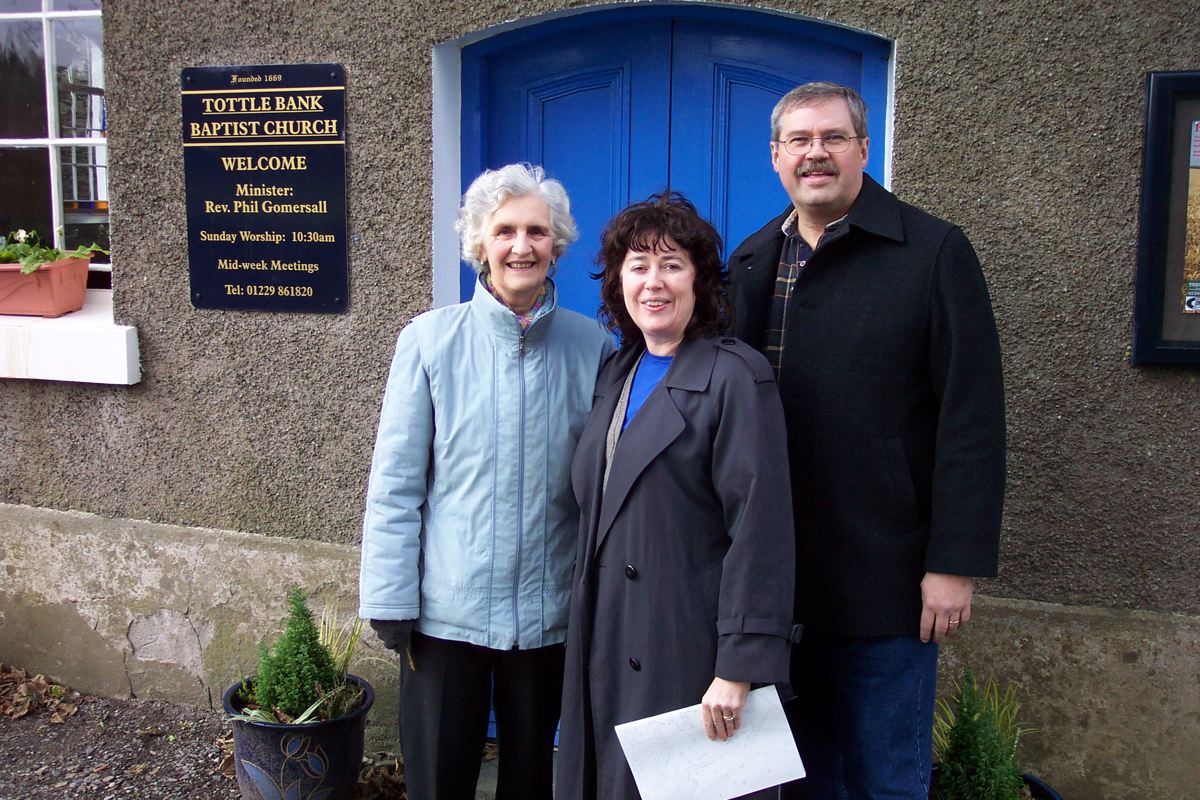
Scott & Jenny Harp with caretaker of Tottlebank church, November, 2006
Directions To Kirkby Church
Kirkby Church of Christ at Wall End is located in Northeast England near the lake district, not far from Ulverston. The address is Kirkby-in-Furness, Cumbria LA17, UK 37 ft SW.
GPS Location
54.238742,-3.176184
View Larger Map
Photos Of Kirkby
Church of Christ At Wall End
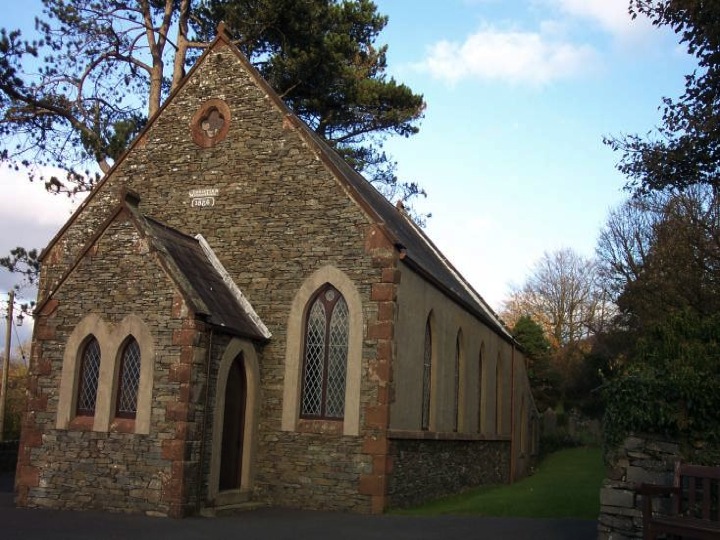
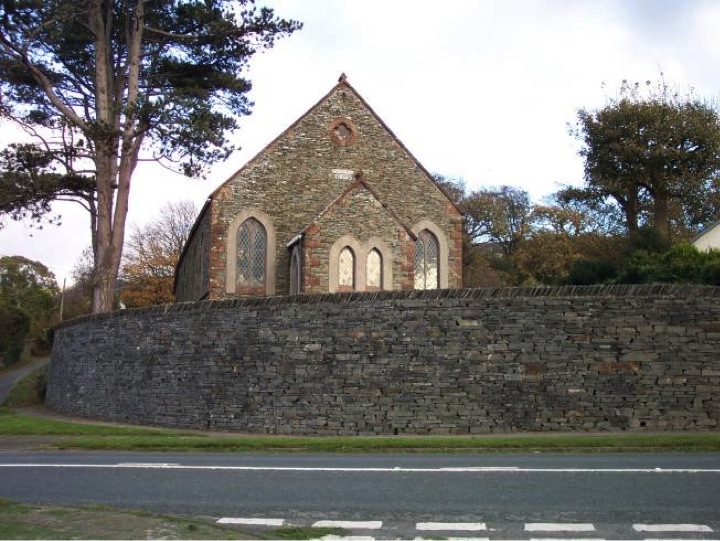
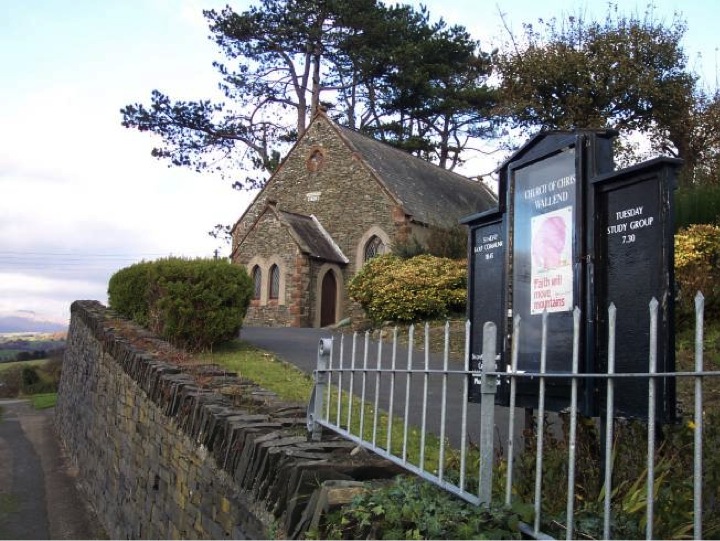
Church of Christ
Wall End
William Robinson
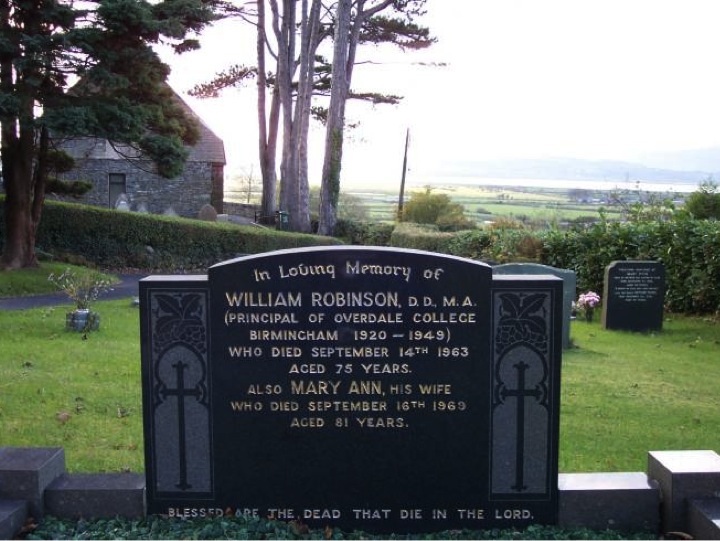
In Loving Memory of
William Robinson, D.D., M.A.
(Principal of Overdale College
Birmingham 1920-1949)
Who Died September 14th 1963
Aged 75 Years.
Also Mary Ann, His Wife
Who Died September 16th, 1969
Aged 81 Years
Blessed are the dead that die in the Lord
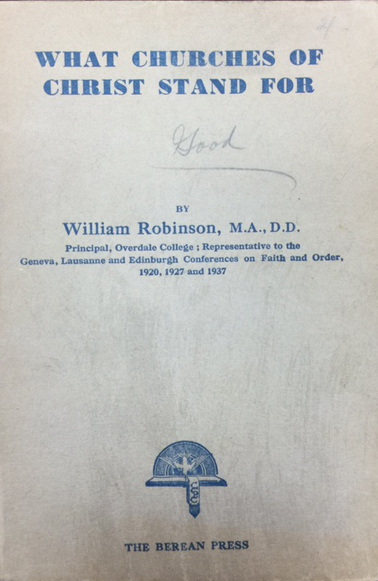
What Churches of Christ Stand For
by William Robinson
open .pdf here
William McDougall
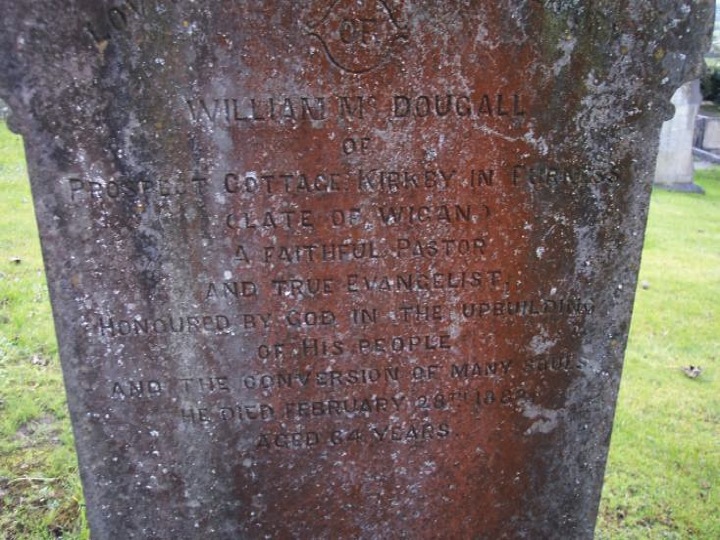
William M. McDougall
Of
Prospect Cottage Kirkby In Furness
(Late Of Wigan)
A Faithful Pastor
And True Evangelist
Honoured By God In The Upbuilding
Of His People
And The Conversion Of Many Souls
He Died February 28, 1882
Aged 64 Years
![]()
Photos Taken November, 2006
Courtesy of Scott Harp
www.TheRestorationMovement.com
Special thanks to Graham McDonald, Scotland citizen and missionary. He and his family were hosts to the Harps in November, 2006. Graham very kindly drove us around the country to various locations of the Reformation & Restoration Movement. Also, thanks is extended to C. Wayne Kilpatrick for his 1977 research paper on Tottlebank and Kirkby above.
![]()
